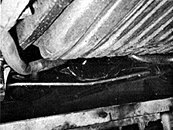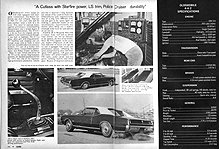|
|
|
|
|
|
|
|
|
|
|
|
|
|
|
"A Cutlass with Starfire power, LS trim, Police Cruiser durability" |
|
|
|
Unlike most of the so-called super-cars in its class, the 4-4-2 isn't merely an image car that looks and sounds like a hot-rodded stocker. It's a genuine supercar, even though it does have hood louvers that do little more than vent the area between the layers of hood stock and multi-colored "status stickers". What is not visible from the outside is the superbly engineered chassis and suspension, which was originally designed for highway patrol pursuit work, and the torque-laden 400 cubic-inch engine which thrives on high rpm operation. Our test car was fitted with an additional goodie which was also not visible from the outside, a #397329 "cold air" cam which is used in conjunction with stiffer springs and a fresh air intake system for the Quadrajet. Since production of the '67 "cold air" packages had not begun at the time our car was being built, we settled for the camshaft and valvetrain only which was in stock in Lansing. When we picked up our test car it had 209 miles on the clock and was in typically-dealer-prepared shape. In all honesty it was quite sluggish for a 4-4-2 and just about hit 5000 rpm before valve float set in.
The car itself felt tight as a drum, but the engine obviously wasn't "right there". As planned, the car was turned over to Joel Rosen, who runs Motion Performance, Inc. in Baldwin, New York, after we put an additional 200 miles on the clock. Joel's specialty is super-tuning, both for street and strip, high-performance factory stockers. He was instructed to test drive the car, dyno tune it to street specifications, test drive and report to us. The culprits turned out to be a full tank of less-than-desireable octane fuel, a 7-degree-off advance curve, too lean a mixture, too hot a heat range plug for the capacitive discharge ignition and an extremely tight engine. Olds advised us that maximum performance can't be expected from a 4-4-2 with less than 1000 miles on the engine. This proved to be true as the car got progressively stronger without any additional modifications as we put on the miles. Joel played with the Quadrajet, installed colder Champion J-10Y plugs and set the total advance curve at 35 degrees. In the future we plan to publish a complete report on super-tuning the 4-4-2. |
|
|
|
During the course of the 1000-mile evaluation period we realized that even though the car is little changed from it's predecessors it's an animal of another breed. Now the car stops as well as it handles. Last year the 4-4-2 relied on the GM 9.65-inch intermediate drum brakes which were barely adequate for the six-cylinder F-85 models. This year there are optional power discs listed for the front (Delco-Morraine 11-inchers with vented discs) which offer fantastic resistance to fade and require a minumum of pedal pressure. The only-minus feature is that the styled steel Super/Stock wheels can't be ordered on a disc-braked machine because of caliper clearance. We found the discs invaluable as they gave up piece of mind when we occasionally let it out throwing power shifts at 5800 rpm!
Olds has had the handling edge on its intermediate competition since all this supercar jazz started in 1965. Since the 4-4-2 chassis was originally designed for police pursuit work, it required almost no changes when the high-performance "super-package" was developed. Under the roughest of conditions we found our test car to be a fairly neutral steerer, which is saying a lot for a car of this type. It's cornering characteristics are completely predictable, and with the close-ratio four-speed, 3.90 gears and Firestone Wied Ovals, minor oversteer can be induced when you want to "let it all hang out." The quick-ratio manual steering (ratio not as quick as the power-assisted setup) affords a full feeling of the road and precise control of the car. The front/rear tuned sway bar package (only production car in its class to have such a setup) consists of a .937-inch bar up front and a .875-incher at the rear and does a first class job of off-setting excessive lean and loss of the footprint on tight corners. On city streets the engineered safe suspension took away very little from the car's excellent ride qualities. The ride was obviously stiffer and there was some transmission of road noise. The steering was not objectionable, except when negotiating typical tight city parking spaces. However, the plus-features of the suspension outweigh the minus ones. Anyone that wouldn't sacrifice a little comfort for a whole lot of safety and high-speed handling control shouldn't buy a supercar in the first place! The one place the car really surprised us was on the strip. We had already driven a similarly-equipped 4-4-2 at the General Motors Proving Grounds, so we turned our test car over to Frank Musico, a friend who owns a '66 4-4-2 equipped with 4.33-to-1 gears, Crane cam, Hooker headers, tri-power, mag wheels and all that jazz. At first he wasn't impressed, but after making five or six passes he gave in. "It's much stronger than mine was when it was new, and truly unreal in the 4000-to-5800 rpm range," said our track tester. "Besides, the suspension seems a lot sturdier, the disc brakes are fade-free and the clutch never sticks to the floor, power-shift after power-shift. Let me tell you like it is, I can come off at 4500 rpm with the Wide Ovals, power-shift at 5800 and go through the traps flat out without a trace of lifter pump up. This car's bear!" The best time recorded through the traps was 100 mph in 14.20 seconds, which we consider quite respectable for a 3700-pound stock car equipped with closed exhausts and Wide Ovals. We also made a few 0-to-60 mph passes, as this is what most of the supercars are bought for, and managed to stop the clock between 6.8 and 7.2 seconds. This we also consider good as the Cold-Air-cammed 400 cubic-incher is not a low-end engine. Where this engine excels is in the mid and top range of the scale. Over 4000 rpm the engine feels like it just received a shot of adrenalin and it climbs strong as a bear to 5800 rpm. Because of the torque curve of the engine when fitted with the COld Air cam it can really use "big numbers" in the rear, such as the popular 4.33 (dealer installed) drag setup. The Cold Air cam checks out at .474-inches lift and308 degrees duration and can be identified by four orange stripes. |
|
||||
|
|
Even when
fitted with the optional Cold Air cam and valve train the 400-cubic-inch engine is still
docile enough for everyday transportation. Throughtout the 1000-mile test the engine never
failed to start immediately without fuss or muss. We were able to idle the engine down to
800-900 rpm for a noise and vibration-free performance. The 10.5-to1 compression ratio and
35-degree ignition setup worked well with 260 Sunoco, but would not get along on
lesser-rated octane fuel. Even with the Sunoco there were traces of ping or detonation
during max muscle runoffs, but it wasn't serious enough to cut back on the timing. The
stock Quadrajet engine is rated at 350 hp to 5000 rpm, 440 foot pounds of torque at 3600
rpm, and carries a 5200 redline. There are no published figures on the W-30 Cold Air
engine, but according to our track and dyno tests the engine pulls at least another 10-15
hp when equipped with the cam and kit alone and is good for a 6200 rpm redline when
super-tuned. Joel Rosen actually pulled 170 real wheel hp at 4000 rpm on the dyno after
standard tuning and a shade over 180 hp after super-tuning (new jetting, spacer plates
under carb, blocked PCV and vacuum advance). According to Joel these figures are extremely
impressive for a car factory-rated at 350 hp.
Another one of the impressive features of our car was the powertrain, which consisted of the GM 2.20 First gear four-speed with Hurst Competition-Plus linkage and an all-new, Olds-manufactured rear end. With the Hurst stick no problems arose knocking off power-shift after power-shift without even giving a thought to "neutral hangup." At the receiving end of the "torque transmission" is a new super-beefy rear which is just the ticket for track or traffic. The rear also boasts a larger ring and pinion assembly, one case that will handle ratios to 3.91-to-1, big car 31-spline axles, higher capacity differential side bearings, new high friction limited-slip discs and a super-duty-constructed housing. Rear end failure has always been a sore point when setting up a stock GM intermediate for the drags, but Olds has solved this problem. The new rear is a "house" item and is used only on the Olds line. The interior of the 4-4-2 is plush, comfortable and easy on the eyes. The buckets put the driver and front passenger in complete control of the scene, and if you want to go for the Rocket Rally pac you can reap the benefits of complete instrumentation. Our car was fitted with this option which enabled us to keep an eye on what was happening under those louvers. The tach, which assumes the front center mounting position, is good for the street, but leaves a lot to be desired for dragging. A good large-faced tach, which mounts in the driver's line of sight, is recommended for serious running. Since our car was also fitted with the adjustable steering wheel, we were able to tailor the wheel's position to our exacting specifications. Impressed with the engineering and quality control of our test car, we actually hated to turn it back to Olds. The stiffer ride, the "strong arm" steering and the compressed instrumentation were overshadowed by the car's precise handling characteristics, flawless brake power, and engine performance throughout a wide torque range. Another plus-feature we must mention is the heavy duty radiator. With this radiator installed in our test car, we were able to run the car under full load on the dyno, make eight passes through the traps, and then go out in bumper-to-bumper traffic without ever seeing the needle reach the normal marker on the temp gauge. It's a must for the performance buff, or the executive who runs back and forth to work in his air-conditioned 4-4-2! But the one really plus-feature of this "anti-boredom bundle" is that when you come up to a light in it there's a heck of a good chance that you won't run up against a carbon copy. GTO owners can't make that statement! |
|
|
|
|
|
||||||||||||||||||||||||||||||||||||||||||||||||||||||||||||||||||||||||||||||||||||||||||||||
|
|
|
x |
 New UHV capacitive discharge ignition works with a pointless ignition.  Rear sway bar is 4-4-2 exclusive, key to car's precise handling qualities. |
|
|
|
|
|
||||||||||||||||||||||||||||
|
|
 |
 |
 |
 |
|
|
|
|
|
|
|
|
|
|
|
Want to link to this site? Please
use this banner. The correct URL for this website is http://www.OLDSmobility.com/) |
|
|
|